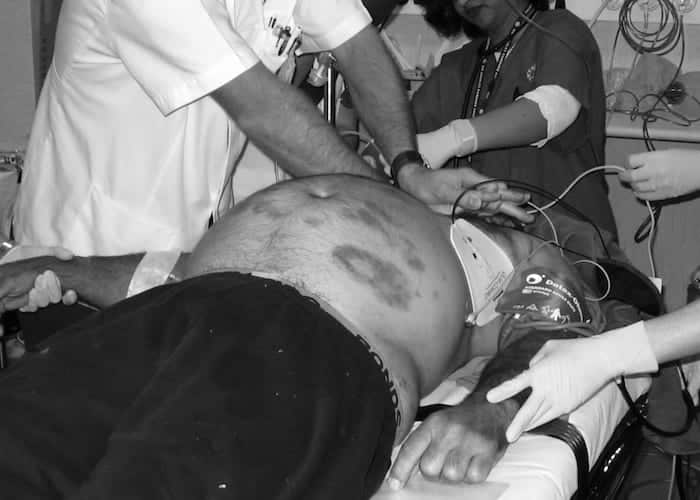Do you know if you really own the airway?
How often does a junior medical officer (or in-fact one of your senior colleagues) in your ED have four attempts at intubating a patient before he, or she, finally succeeds?
How often do patients desaturate during RSI in your department?
Apnoeic oxygenation is all the rage but is it really being utilized?
We think we have a good idea of departmental performance but until we start collecting data on EVERY intubation, we will never have a reliable picture of what we do.
Without this reliable picture, we will never be able to target our education to improve our performance. We will never be able to evaluate new techniques or equipment.
I have been collecting data at RNSH for 2 years now and have data on over 400 episodes of intubation – here are some of the findings:
- Trauma accounts for 30% whilst strokes/ICHs and overdoses account for approximately 15% each.
- 20% occur when an EP is not around to supervise but we don’t have an increased rate of complications out of hours – cudos to the registrars!
We don’t see many bariatric patients – only 3% had an estimated weight >109kgs. - Our first pass success is 83%, and 87% of these first looks are undertaken by registrars or SRMOs. This doesn’t leave much practice for the specialists – 3 each per year on average! That makes me worry about skill fade.
- We found that the juniors who hadn’t done any time in anaesthetics had only a 50% success rate (and they were presumably given the easy ones to “have a go” on). We felt this was sub optimal and so have developed a credentialing package that involves an anaesthetic term to bed down basic airway skills and then a simulation session to learn to intubate sick patients in ED.
- Our laryngoscopy skills are a bit under par – 23% Cormack and Lehane 3-4!
- Naked intubation has been banned. I’d better explain – bougies (or stylets for the nonbelievers) are mandatory for all. As we have shown (again) that they do improve your chance of first pass success. The difficulty seems to lie in persuading the trainees that a patient who you think is going to be straightforward can easily trick you. Make life easy – optimise your preparation for first pass success.
- Desaturation occurs in 15% but 9% started off 2 attempts.
There are more graphs and data on the website AirwayRegistry, as well as a copy of the data collection sheet I use.
Since this project was launched onto the blogosphere a few weeks ago the interest has been phenomenal and I would encourage anyone who manages an airway in ED to get in touch with me. I’d be happy to enlist your department as a recruiting site for what I would love to turn into a multicentre database: The ANZEDAR – The Australia and New Zealand ED Airway Registry! (Suggestions for better acronyms gratefully accepted)
Finally I’d like to share a letter written to our DEMT by one of the junior registrars (permission granted). It will ring a few bells for most readers and underlines why it’s not the fancy laryngoscopes that count when the chips are down, it’s the basics that so often make a difference.
I wanted to let you know about a positive solo experience I had on the ward during an ICU locum night shift at a private hospital. My airway/resus training at RNSH ED played a huge role in helping me to stabilise and save this patient’s life.
It was 0030 hrs in the morning when I was called to see an unrousable patient (who may have been that way for up to ten minutes prior). On arrival in the room I found a 60 yr. old lady with a heavily strapped right shoulder (after a shoulder arthoplasty that afternoon). She was unresponsive and clearly had an obstructed airway (grunting with paradoxical respiratory attempts). Not only was she blue, she was also obese, short necked, and had a small jaw. Her saturations at the time were 44% with HR 70, SBP 150.
I attempted to perform airway maneuvers and insert a Guedel airway – both of which failed to improve the saturations. She had trismus to compound the problem. No nasopharyngeal airways on the trolley. With a bag-valve mask I was able to ventilate her saturations up to 90% but no better (the saturations continued to fluctuate between 85 and 90%). There was significant resistance to ventilation.
A quick glance at the notes showed no significant PMHx and only morphine in recovery + a morphine PCA at the bedside. I gave 2 x200mcg Naloxone doses that failed to improve her GCS.
By this point I had an experienced ICU nurse + two very inexperienced orthopaedic nurses at the bedside helping during the arrest. There were no other doctors on site. I had one of the nurses phone the ICU consultant to let him know I would need to intubate the patient on the ward. He was 30 minutes away so advised to go ahead.
Sweat beads. Wet pits. Full backside of pants. My HR 179. Am now rethinking career choice.
I got a laryngeal mask brought down from the ICU in the event of a failed attempt (another piece of airway equipment not on the trolley). I gave the patient suxamethonium and propofol. The trismus relaxed and resistance to ventilation improved with muscular blockade and I was able move more air – saturations improved to 100%
I stuck a pillow under her shoulders (Toby Fogg trick I think), and then preloaded a bougie with an ETT. The airway was a grade 3 at first view. I manipulated the larynx and was able to see the cords – the ICU nurse was helpful with maintaining that view.
From there I was able to intubate the trachea with the bougie and pass the ETT without obstruction Capnography (old school litmus paper type capnography) was reading positive and saturations improved to 100%.
I took my first breath for the previous minute
Guest Author
Dr Toby Fogg, Emergency Physician at Royal North Shore Hospital (RNSH) in Sydney and Retrieval Specialist with CareFlight.

CLINICAL CASES
Ruling the Resus Room
Chris is an Intensivist and ECMO specialist at The Alfred ICU, where he is Deputy Director (Education). He is a Clinical Adjunct Associate Professor at Monash University, the Lead for the Clinician Educator Incubator programme, and a CICM First Part Examiner.
He is an internationally recognised Clinician Educator with a passion for helping clinicians learn and for improving the clinical performance of individuals and collectives. He was one of the founders of the FOAM movement (Free Open-Access Medical education) has been recognised for his contributions to education with awards from ANZICS, ANZAHPE, and ACEM.
His one great achievement is being the father of three amazing children.
On Bluesky, he is @precordialthump.bsky.social and on the site that Elon has screwed up, he is @precordialthump.
| INTENSIVE | RAGE | Resuscitology | SMACC

